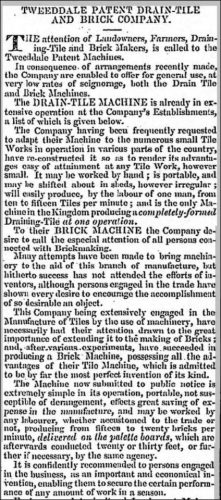1 Garnkirk
— 23/12/2023Found by Ian Suddaby in the Ravenscraig, Motherwell area. This example is not in my possession. Garnkirk Fireclay Works, Garnkirk, Lanarkshire. The stamp reads either 1 or I Garnkirk. . .

19/10/ 1836 – List of patents referred to in Newton’s London Journal of Arts and Science 1837 (page 117) – states – George, Marquis of Tweeddale, for an improved method of making tiles for draining soils, house tiles and flat and roofing tiles and bricks – the word ‘bricks’ having been omitted in former patent of 25th May last.
09/12/1836 – Patents for inventions. Abridgements of specifications.
No 7253 – George Marquis of Tweeddale. Forming drain tiles by passing the clay from the feeding hopper between two horizontal cylinders on to an endless web, which passes over a shaping cylinder, turned out in the middle to the form of a drain tile ; after which the tile is completed by passing between a pair of inclined rollers and a second shaping cylinder, and is carried by two narrow endless bands beneath a cutting wire, and thence by an endless web to the drying shed.
Making flats or soles by passing the clay between the horizontal cylinders on to an endless band, by which it is carried to the cutting wires.
Flat roofing tiles of equal thickness throughout are made in like manner; but if required to be thin at the upper or nail end, or to have a flat knob or prominence on the end, the upper horizontal cylinder must be suitably shaped. A nail-hole is made in each tile by a punch attached to a lever. An instrument for placing flat tiles on the drying shelves instead of the common peal.
Bricks are produced by modifying the machinery used in manufacturing flat tiles.
House tiles are formed by a pair of moulds, the upper worked by a lever or crank, and the lower capable of sliding on a rod out of its frame to deliver the tile.
The clay is prepared by passing between a pair of large crushing cylinders and is then milled in the usual way.
01/08/1838 – Patents for inventions. Abridgements of specifications. No 7757 – Tweeddale, George Marquis of. — The invention forming the subject of these Letters Patent is the same as N° 7253. By the former Letters Patent the invention was protected in England, Wales, and the town of Berwick-upon-Tweed; and these Letters Patent were granted to extend the protection to the Colonies.
Below – 13/07/1839 – Mechanics Magazine – Describes Tweeddale’s brick and tile making machinery.
Below – 31/07/1839 – Inverness Courier – Article on the positives of buying a Tweeddale tile making machine.

12/09/1839 – Falkirk Herald – Mr Cottam exhibited a model of a brick and tile making machine invented by the Marquis of Tweeddale by which it was stated that 30 bricks per minute or nearly 30,000 bricks a day could be made while a good moulder could only mould from 5000 to 8000 a day.
29/10/1839 – London Gazette – The yester or Marquis of Tweeddale’s patent for making tiles and bricks, notice is hereby given, that application is intended to be made to Parliament in the next session, for an Act to authorise the assignment to a company or companies, or to more than twelve persons, of certain letters patent granted to the Most Honourable George Marquis of Tweeddale, for his invention of an improved method of making tiles for draining, soles, house tiles, flat roofing tiles, and bricks and to enable such assignees to make, use, exercise, and vend the said invention, and to grant licences for making, using, exercising, or vending the same within the United Kingdom of Great Britain and Ireland, and Her Majesty’s colonies and plantations abroad. And it is intended by the said Act either to incorporate the said company or companies or to give them powers to sue and, be sued in the name of one or more of their directors or officers. Swain, $tevens, and Co., 10, Whitehall, and 6 Frederick’s Place, Old Jewry, London.
Below – 1841 – Describes a modification to Tweeddales machine by James White, 11 East Place Lambeth.




Below – 1861 – Advert – Robert Bridges Engineer, North Berwick Marquis of Tweeddale – Tweeddale Company’s Brick Machines.
Many brick and tile works were instigated by improving estate owners – George Hay, 8th Marquis of Tweeddale, obtained a patent for innovative tilemaking equipment in 1839. In general, these rural works were small scale.
Marquis of Tweeddale is mentioned in Newton’s London Journal of Arts and Sciences dated 1843 – page 369 – 70.
Field Marshal George Hay, 8th Marquess of Tweeddale, KT, GCB (1 February 1787 – 10 October 1876) was a Scottish soldier and administrator. He served as a staff officer in the Peninsular War under Arthur Wellesley and was with Wellesley at the Second Battle of Porto when they crossed the Douro river and routed Marshal Soult’s French troops in Porto. Hay also saw action at the Battle of Bussaco and at the Battle of Vitoria. He later served in the War of 1812 and commanded the 100th Regiment of Foot at the Battle of Chippawa when he was taken prisoner of war. He went on to become Governor of Madras and, at the same time, Commander-in-Chief of the Madras Army, in which role he restored the discipline of the army, which had been allowed to fall into a relaxed state.
*****************************